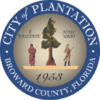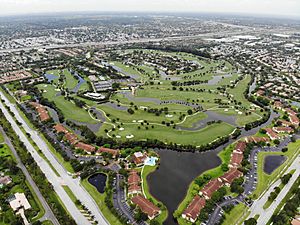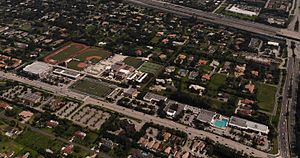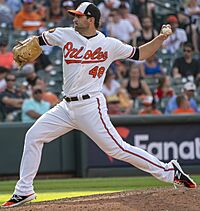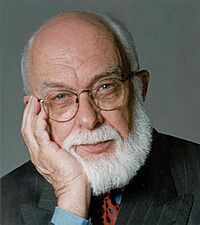Plantation, Florida facts for kids
Quick facts for kids
Plantation
|
|||
|---|---|---|---|
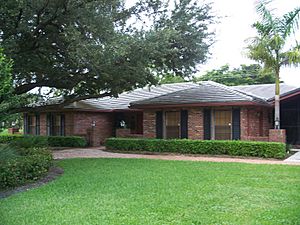
Plantation Historical Museum
|
|||
|
|||
| Motto(s):
"The Grass is Greener" and
"E Vasitate Haec Urbs" |
|||
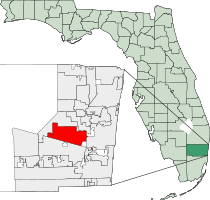 |
|||
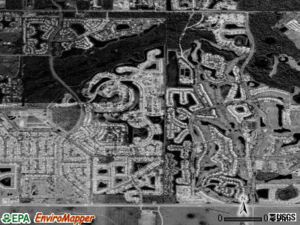
Satellite view of Plantation
|
|||
| Country | |||
| State | |||
| County | Broward | ||
| Incorporated | April 23, 1953 | ||
| Government | |||
| • Type | Mayor-Council | ||
| Area | |||
| • City | 22.05 sq mi (57.12 km2) | ||
| • Land | 21.75 sq mi (56.33 km2) | ||
| • Water | 0.30 sq mi (0.78 km2) 0.87% | ||
| Elevation | 9 ft (2.75 m) | ||
| Population
(2020)
|
|||
| • City | 91,750 | ||
| • Density | 4,218.20/sq mi (1,628.66/km2) | ||
| • Metro | 6,166,488 | ||
| Time zone | UTC-5 (EST) | ||
| • Summer (DST) | UTC-4 (EDT) | ||
| ZIP Codes |
33311, 33313, 33317, 33322-33325, 33388
|
||
| Area codes | 754, 954 | ||
| FIPS code | 12-57425 | ||
| GNIS feature ID | 0289024 | ||
| Website | http://www.plantation.org | ||
Plantation is a city located in Broward County, Florida, in the United States. It is part of the larger South Florida metropolitan area. The city got its name from the Everglades Plantation Company. This company once owned the land and tried to grow rice there, but it didn't work out. In 2020, about 91,750 people lived in Plantation.
Contents
History of Plantation
Early Days and Land Drainage (1855–1930)
Before the 1900s, the area where Plantation now stands was mostly Everglades wetlands. It was often covered by 2 to 3 feet of water. In 1855, Florida created a special fund to manage and develop state land. The Seminole people used this area for hunting and fishing. They also used Pine Island Ridge as a base during wars.
In 1899, Florida's Governor William Sherman Jennings started a plan to drain the Everglades. His goal was to create more usable land. The next governor, Napoleon Bonaparte Broward, continued this effort. He wanted to turn the Everglades into an "Empire."
The first attempts to drain the land began in 1906. Large machines called dredges were used to dig canals. These canals helped move water out of the wetlands. One important canal was the North New River Canal.
In 1908, a deal was made with Richard 'Dicky' J. Bolles. He bought a lot of state land at a low price. The state promised to use half the money for drainage. Bolles then started the Florida Fruit Lands Company. This company became the first private developer in the Everglades.
The Everglades Plantation Company started in 1909. They planned to create a rice farm in the Everglades. They rented a large area of land near the North New River Canal. However, much of this land stayed underwater.
In 1911, Bolles tried to sell land through a lottery. But the land remained flooded, leading to a lawsuit against him. The North New River Canal opened in 1912. The Sewell Lock, the first lock in Florida, was built on it. This lock helped boats travel between the Everglades and Lake Okeechobee.
The drainage efforts largely failed. Much of the land went back to the state. However, two farmers, O. L Daniel and Dewey Hawkins, bought large parts of it. In 1915, Broward County was created. It was named after Governor Broward.
The Florida Land Boom happened between 1920 and 1925. This was a time of fast growth and land sales. But the boom ended in 1926. Two strong hurricanes hit the area in 1926 and 1928. They caused a lot of damage and flooding. After these storms, more money was spent on flood control.
Starting to Build the City (1931–1952)
Frederick C. Peters, who would later found Plantation, moved to Florida in 1931. He bought 10,000 acres of land in 1939. This land was mostly owned by Dewey Hawkins and the Everglades Plantation Company. Peters wanted to create a farming community.
He built the first ranch buildings in 1942. Peters then hired an architect to help plan the city. In 1946, a special group called the Old Plantation Water Control District was formed. Their job was to drain the land and manage the canals.
Chauncey Clark Jr. helped Peters develop the land. His father, Chauncey Clark Sr., came up with a plan for one-acre lots with small houses. The first homes were built in 1947. The area became known as 'Plantation'. This name then became the name of the whole city.
Early on, many homes were destroyed by floods from heavy rains and hurricanes. But Clark repaired them at his own cost. In 1948, Chauncey Clark Jr. and his family moved into the first finished home. About 120 homes were built that year. The city's population grew to 30 families. The first child born in the city was Eugene Carter.
More hurricanes hit in 1948, causing more flooding. House sales stopped in 1949. But work continued on roads, dikes, and houses. The Plantation Women's Club and the Plantation Homeowners' organization were also started. By then, 40 homes were occupied. In 1950, the Plantation Golf Course and Country Club opened.
Plantation Becomes a City (1953–1963)
The city of Plantation officially became a city on April 23, 1953. At that time, it had about 300 people. Ellsworth D. Gage was appointed as the city's first Mayor. The first city council meeting was held in a building that was also used as a warehouse. This building is now part of the Deicke Auditorium.
In 1954, the Miami Herald newspaper called Plantation "The City of the Future." S. Robinson Estey was elected as the city's second mayor in 1955. The Plantation Police Department was also started that year. Henry C. 'Hank' Donath was the first officer.
The city's fire department started its annual barbecue fundraiser in 1956. The Volunteer Fire Department was formed in 1957. The city's first industrial plant, Airpax Products, Co., opened in 1957. The Sunshine State Parkway, now Florida's Turnpike, also opened. By 1958, the City Hall was finished.
In 1959, the city's first school, Berenice Todd Peters Elementary School, was dedicated. It was named after the founder's wife. Hank Donath became the city's first police chief. In 1960, the city adopted "The Dream City" as its slogan.
The Plantation Library opened in 1961 at Peters Elementary School. In 1962, Edwin Deicke donated money to expand the Hoffman Building, which was later renamed Deicke Auditorium. The city's chamber of commerce and Doctors General Hospital also opened.
By 1963, Plantation's population reached 8,500. The city's original motto, "From the Wilderness, This City," became official. A new community center was built, which became the home of the city library.
Growth with Gulfstream (1964–1979)
After Frederick C. Peters passed away in 1964, his family sold a large area of undeveloped land to the Gulfstream Land Development Company. This company planned to build a new community called Jacaranda. They wanted it to be like Coral Gables.
More schools and hospitals were built during this time. These included Plantation Elementary School (1965), Plantation High School (1966), and Plantation General Hospital (1966). A facility for the company Motorola also opened in 1969.
By 1970, Plantation's population grew to over 23,500 people. A new city hall was built in 1972. In 1973, areas like Plantation Acres were added to the city. The new Deicke Auditorium and City Hall were dedicated. Gulfstream started focusing on businesses and offices. They made agreements with companies like Motorola and American Express. The Broward Mall was also planned.
The Plantation Historical Society was founded in 1974. Frank Veltri was elected mayor for the first time in 1975. He became the city's longest-serving mayor, serving for 24 years. The financial company American Express moved its operations to Plantation in 1975.
In 1976, a large oak tree was planted in Fifth Street Park to celebrate the US bicentennial. The park was renamed Liberty Tree Park. In 1977, the city and Broward County started working on Plantation Heritage Park.
The Broward Mall opened in 1978. It was the largest mall in the Southern United States at the time. Plantation celebrated its 25th birthday that year. They buried a time capsule to be opened every 25 years.
Recent Times (1980–Present)
By 1980, Plantation's population reached over 48,600. The city was named a 'Tree City' by the Arbor Day Foundation. The Plantation Library was renamed the Helen B. Hoffman Plantation Library in 1981.
In 1983, Plantation Central Park opened. This was a large recreation area with a swimming pool, gym, and sports fields. The Plantation Historical Museum was dedicated in 1985.
The city started the PLANT (Plantation Landscaping Award for Nurturing our Town) awards in 1984. These awards recognize great landscaping. Plantation Heritage Park also opened to the public that year.
In 1988, two new shopping malls opened: The Fountains Shopping Mall and the Fashion Mall at Plantation.
By 1990, the population reached over 66,000. In 1991, Marjory Stoneman Douglas, a famous conservationist, was honored for her work to protect the Everglades.
The insurance company Kemper National Services opened in Plantation in 1993. At this time, American Express and Motorola were the city's biggest employers.
In 1996, the Olympic Flame relay run passed through Plantation. A large fire happened at the Plantation Towne Mall that year. The mall was rebuilt as Plantation Towne Square.
By 2000, the city's population was over 82,900. New community centers and parks were built around this time. Plantation celebrated its 50th birthday in 2003.
Hurricane Wilma hit Plantation in 2005, causing a lot of damage. The Fashion Mall closed in 2006 because of the damage. In 2007, the Broward Mall was bought by the Westfield Group and renamed Westfield Broward.
Plantation was named one of the "100 Best Communities for Young People" in 2008. It won this award again in 2010 and 2011.
In 2011, Diane Veltri Bendekovic, the daughter of former mayor Frank Veltri, was elected mayor. The city's 60th anniversary in 2013 was celebrated with a new book about its history.
The old Fashion Mall property was sold in 2015. Demolition began in 2016 to make way for Plantation Walk. This new project will include apartments, shops, restaurants, and a hotel.
In 2017, the American Express office in Plantation closed. A new mixed-use development called 'Plantation Midtown' is planned for that site.
In 2019, a gas explosion happened at a shopping plaza. It caused a lot of damage to buildings.
In 2020, some people suggested changing the city's name. This was because the word "plantation" can be linked to slavery. However, the city's name comes from the Everglades Plantation Company and has no direct link to slavery. Many residents did not want to change the name.
In 2021, Westfield Mall went back to its original name, Broward Mall.
Geography

Land Size and Location
Plantation covers about 21.93 square miles (56.8 km2). Most of this area is land, with a small part being water.
The city is located in the middle of Broward County. It shares borders with Lauderhill to the northeast, Sunrise to the north and west, Davie to the south, and Fort Lauderdale to the east.
Climate
Plantation has a tropical climate. This means it is warm all year round. August is usually the hottest month. January is the coolest month.
Here are the average monthly temperatures and rainfall:
| Climate data for Plantation, Florida | |||||||||||||
|---|---|---|---|---|---|---|---|---|---|---|---|---|---|
| Month | Jan | Feb | Mar | Apr | May | Jun | Jul | Aug | Sep | Oct | Nov | Dec | Year |
| Record high °F (°C) | 88.0 (31.1) |
94.0 (34.4) |
92.0 (33.3) |
94.0 (34.4) |
98.0 (36.7) |
98.0 (36.7) |
99.0 (37.2) |
98.0 (36.7) |
98.0 (36.7) |
98.0 (36.7) |
91.0 (32.8) |
89.0 (31.7) |
99.0 (37.2) |
| Mean daily maximum °F (°C) | 75.0 (23.9) |
77.0 (25.0) |
79.0 (26.1) |
82.0 (27.8) |
86.0 (30.0) |
89.0 (31.7) |
90.0 (32.2) |
90.0 (32.2) |
89.0 (31.7) |
86.0 (30.0) |
81.0 (27.2) |
77.0 (25.0) |
83.4 (28.6) |
| Mean daily minimum °F (°C) | 57.0 (13.9) |
59.0 (15.0) |
62.0 (16.7) |
66.0 (18.9) |
71.0 (21.7) |
75.0 (23.9) |
75.0 (23.9) |
76.0 (24.4) |
75.0 (23.9) |
72.0 (22.2) |
66.0 (18.9) |
60.0 (15.6) |
67.8 (19.9) |
| Record low °F (°C) | 28.0 (−2.2) |
31.0 (−0.6) |
32.0 (0.0) |
40.0 (4.4) |
54.0 (12.2) |
60.0 (15.6) |
64.0 (17.8) |
66.0 (18.9) |
61.0 (16.1) |
47.0 (8.3) |
35.0 (1.7) |
30.0 (−1.1) |
28.0 (−2.2) |
| Average precipitation inches (mm) | 2.62 (67) |
3.36 (85) |
3.58 (91) |
3.52 (89) |
6.20 (157) |
9.81 (249) |
7.41 (188) |
8.00 (203) |
9.45 (240) |
6.40 (163) |
3.90 (99) |
2.39 (61) |
66.64 (1,692) |
| Source: The Weather Channel (Monthly Forecast) | |||||||||||||
People of Plantation (Demographics)
| Historical population | |||
|---|---|---|---|
| Census | Pop. | %± | |
| 1960 | 4,772 | — | |
| 1970 | 23,523 | 392.9% | |
| 1980 | 48,653 | 106.8% | |
| 1990 | 66,692 | 37.1% | |
| 2000 | 82,934 | 24.4% | |
| 2010 | 84,955 | 2.4% | |
| 2020 | 91,750 | 8.0% | |
| U.S. Decennial Census | |||
Population Changes
The population of Plantation has grown a lot over the years. In 1960, there were less than 5,000 people. By 2020, there were over 91,000 people living in the city.
| Historical demographics | 2020 | 2010 | 2000 | 1990 | 1980 |
|---|---|---|---|---|---|
| White (non-Hispanic) | 41.4% | 53.7% | 68.0% | 84.0% | 94.8% |
| Hispanic or Latino | 28.0% | 20.4% | 13.1% | 8.1% | 3.5% |
| Black or African American (non-Hispanic) | 20.7% | 19.4% | 13.4% | 5.8% | 0.9% |
| Asian and Pacific Islander (non-Hispanic) | 4.5% | 3.8% | 2.9% | 1.8% | 0.8% |
| Native American (non-Hispanic) | 0.1% | 0.2% | 0.1% | 0.1% | |
| Some Other Race (non-Hispanic) | 1.1% | 0.5% | 0.4% | 0.1% | |
| Two or more races (non-Hispanic) | 4.2% | 2.0% | 2.1% | N/A | N/A |
| Population | 91,750 | 84,955 | 82,934 | 66,692 | 48,501 |
Who Lives Here?
| Race / Ethnicity (NH = Non-Hispanic) | Pop 2000 | Pop 2010 | Pop 2020 | % 2000 | % 2010 | % 2020 |
|---|---|---|---|---|---|---|
| White (NH) | 56,411 | 45,599 | 37,976 | 68.02% | 53.67% | 41.39% |
| Black or African American (NH) | 11,101 | 16,470 | 18,961 | 13.39% | 19.39% | 20.67% |
| Native American or Alaska Native (NH) | 107 | 146 | 135 | 0.13% | 0.17% | 0.15% |
| Asian (NH) | 2,359 | 3,221 | 4,146 | 2.84% | 3.79% | 4.52% |
| Pacific Islander or Native Hawaiian (NH) | 36 | 46 | 26 | 0.04% | 0.05% | 0.03% |
| Some other race (NH) | 337 | 422 | 1,003 | 0.41% | 0.50% | 1.09% |
| Mixed race or Multiracial (NH) | 1,723 | 1,679 | 3,815 | 2.08% | 1.98% | 4.16% |
| Hispanic or Latino (any race) | 10,860 | 17,372 | 25,688 | 13.09% | 20.45% | 28.00% |
| Total | 82,934 | 84,955 | 91,750 | 100.00% | 100.00% | 100.00% |
In 2020, there were 91,750 people living in Plantation. There were also 34,532 households. A household is a group of people living together in one home.
In 2010, about 23.5% of the people were 19 years old or younger. The average age in the city was about 39.7 years old. More than half of the population was female.
Jobs and Money
Many people in Plantation work in management, business, science, and arts. Sales and office jobs are also very common.
In 2017, the average income per person in the city was about $35,897. The average income for a household was about $69,531. About 9% of the city's population lived below the poverty line.
Languages Spoken
In 2000, most people in Plantation spoke English as their first language (78.01%). Other languages spoken included Spanish (13.00%), French Creole (2.24%), and French (1.31%).
Economy
Plantation has many businesses. In 2012, there were over 13,600 companies in the city. The total sales from stores and businesses were about $1.72 billion.
Some companies with offices in Plantation include DHL and the University of Phoenix. Companies that used to be here include American Express and Motorola.
Shopping Malls
Plantation has two main shopping areas. The Broward Mall is south of Broward Boulevard. The Fashion Mall used to be north of Broward Boulevard, but it closed in 2006. It is now being redeveloped into a new project called Plantation Walk.
Golf and Country Clubs
Plantation is home to several golf courses and country clubs. The Fort Lauderdale Country Club is the oldest, started in 1926. It has two 18-hole courses.
The Plantation Golf Course and Country Club opened in 1950. Its holes were named after Native American tribes. This was to honor the Seminole and Tequesta people who lived there before.
The Lago Mar Country Club is another private golf course. It was built in 1969. The Jacaranda Golf Club is a public club with a large course.
The city also has its own golf course, the Plantation Preserve Golf Course and Club. It opened in 2006.
Education
Most people in Plantation have finished high school. Many also have college degrees.
Plantation's public schools are part of Broward County Public Schools.
Public High Schools
- Plantation High School
- South Plantation High School
Plantation Middle Schools
- Plantation Middle School
- Seminole Middle School
- Bair Middle School (serves parts of Plantation)
Public Elementary Schools
- Central Park Elementary School
- Mirror Lake Elementary School
- Peters Elementary School
- Plantation Elementary School
- Plantation Park Elementary School
- Tropical Elementary School
- Sawgrass Elementary School (serves parts of Plantation)
Private Schools
- American Heritage School and American Academy
- The Blake School
- Our Savior Lutheran
- St. Gregory's Parish School
Higher Education
Media and Entertainment
Plantation is part of a large media area that includes Miami and Fort Lauderdale. This means people in Plantation get their news and entertainment from many TV and radio stations.
The main newspapers for the city are the South Florida Sun-Sentinel and The Miami Herald.
Plantation has also been used as a place to film movies. For example, parts of the movie Caddyshack (1980) were filmed at the Plantation Country Club. The high school in the movie There's Something About Mary (1998) was actually Plantation City Hall.
Famous People from Plantation
Many well-known people have lived in Plantation, including:
- XXXTentacion (1998–2018), a rapper
- Ski Mask The Slump God (born 1996), a rapper
- Somy Ali, a former actress and activist
- Melanie Amaro, a singer who won The X Factor USA
- Daniel Berger (born 1993), a professional golfer
- Richard Bleier (born 1987), a baseball pitcher
- Candace Cameron, an actress
- Carl Hiaasen, a famous novelist and journalist
- James Randi, a stage magician and scientific skeptic
- Darrelle Revis, an NFL football player
- Sloane Stephens, a professional tennis player
- Zach Thomas, an NFL football player
See also
 In Spanish: Plantation (condado de Broward) para niños
In Spanish: Plantation (condado de Broward) para niños



